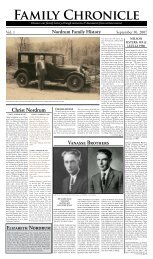Book 2 - Nathan, Amy, Madison and Ethan Berga
Book 2 - Nathan, Amy, Madison and Ethan Berga
Book 2 - Nathan, Amy, Madison and Ethan Berga
You also want an ePaper? Increase the reach of your titles
YUMPU automatically turns print PDFs into web optimized ePapers that Google loves.
in the periphery of the storm.<br />
A boy died on the Atlantic, <strong>and</strong> another was born.<br />
I will never forget the funeral. The ship’s carpenter<br />
made a coffin of rough planks, <strong>and</strong> filled it with s<strong>and</strong><br />
in the bottom. Then he bored holes in the side to make<br />
it sink faster. But it did not sink fast, <strong>and</strong> as the wood<br />
in the coffin had a pale color we could watch it for a<br />
long time as it was slowly sinking.<br />
It was an experience to watch the huge icebergs passing<br />
by. On a distance it would<br />
look as a white thunder sky,<br />
but as we came closer we<br />
could see that it was actually<br />
a mountain of ice.<br />
We had a smooth journey<br />
after the storm, all the way<br />
until we were off Quebec. It<br />
was a narrow entrance <strong>and</strong><br />
unfavorable wind. The Captain<br />
then hired a steamer to<br />
take us into the shore. After<br />
that it took some time to unload<br />
the entire luggage, <strong>and</strong><br />
to have it transported over to<br />
the railway station. I believe<br />
it took about 2 days to get the<br />
job done. The weather was<br />
warm, <strong>and</strong> it felt lovely to<br />
have solid ground under our<br />
feet.” 17<br />
First Stop, Grosse Île, Canada<br />
Twenty days had passed since the Anna Delius<br />
left her port in Norway. The first site of l<strong>and</strong> the<br />
immigrants would see was Grosse Île in the center of<br />
the St. Lawrence River. A m<strong>and</strong>atory quarantine stop,<br />
along with health inspections, would take place before<br />
the ship was allowed entrance into Canada. 18<br />
It is unknown the exact route the Nordrums took from<br />
Grosse-Île, the site of mass tragedy when<br />
Typhoid ravaged hopeful immigrants, ending<br />
the journy abruptly. It is a small isl<strong>and</strong><br />
about 30 miles east of Quebec city, <strong>and</strong><br />
Canada’s poignant <strong>and</strong> visible link with Irel<strong>and</strong>’s<br />
Great Famine of 1845 -1849. In 1832<br />
the isl<strong>and</strong> was designated as a quarantine<br />
stop-over for European immigrants to the<br />
New World. It is estimated there were over<br />
3,226 Irish emigrants who died at Grosse-Île<br />
<strong>and</strong> a further 2,198 who died on board the<br />
ships. Statistics show a total of 5,424 Irish<br />
people are buried in this place <strong>and</strong> many<br />
thous<strong>and</strong>s more dying at sea. 18<br />
13<br />
Quebec to Eau Galle, Wisconsin. Mrs. Ole Torgersen,<br />
a pioneer woman from Menomonie wrote of her journey,<br />
“I left Kristiania the 11 th of April 1868, on the<br />
sail-ship “Hanna Par” (Hannah Parr) <strong>and</strong> sailed for<br />
three weeks, but then a hurricane blew up. The mainmast<br />
<strong>and</strong> one of the other masts broke right at the deck.<br />
Then a pilot came <strong>and</strong> conducted us into Limerick, Irel<strong>and</strong>,<br />
where we remained for 6 weeks while the ship was<br />
repaired. We ate up our traveling food <strong>and</strong> the captain<br />
had to buy provisions for us before we set to sea again.<br />
Arriving in Quebec, we had to<br />
wait for a while again before<br />
we could go further. The trip<br />
continued partly by train,<br />
which resembled the cattle<br />
cars of our day, <strong>and</strong> partly by<br />
boat. We l<strong>and</strong>ed in La Crosse,<br />
Wisconsin, <strong>and</strong> continued the<br />
trip up the Mississippi River<br />
to Reed’s L<strong>and</strong>ing, Minnesota.<br />
From there, up the Chippewa<br />
River to Goose Lake, where<br />
Mrs. Torger Oleson <strong>and</strong> Mrs.<br />
Tore Lund came to lead me to<br />
my destination.” 9<br />
Another pioneer followed a<br />
similar route with this to say<br />
about the train, “This happened<br />
long before the railway<br />
was built down to Menomonie<br />
<strong>and</strong> long before Menomonie was<br />
a city. There was a mixed train, carrying both people<br />
<strong>and</strong> cattle <strong>and</strong> all the goods one needed.” 9 Another,<br />
more probable route was through Muskego. The Nordrums<br />
would have sailed through the Great Lakes,<br />
from Quebec, to Muskego, Wisconsin. Muskego was<br />
the largest, most successful, Norwegian settlement.<br />
Though it was settled on poor soil, it became a rendezvous<br />
point for many immigrants. From Muskego,<br />
many immigrants re-supplied, rested <strong>and</strong> received<br />
valuable information for the journey ahead. 9









